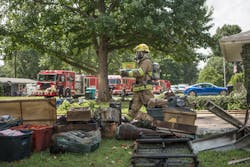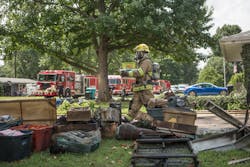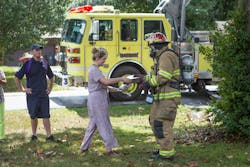In recruit fire training, the curriculum is so rigid and the schedule so tight it’s hard to fit in anything extra. We spend the greatest amount of our time in the fire service assisting the public during their biggest time of need, but in recruit school we spend very little time on customer service.
Customer service training is not a “sexy” topic, but it should be a much higher priority on many departments’ training rosters.
Gain access without causing damage
We all know how devastating a fire can be to a family or individual. Insurance—assuming they have some—usually can cover most of the material items, but the heirlooms are usually irreplaceable. Salvage typically rates pretty low on the list of fireground tactics, and many times it is never accomplished. There are some simple tips we can accomplish during our normal fireground activities to make the tragedy of a fire more palatable for our customers.
First and foremost, entry is a great start. We all love the challenge of conventional forcible entry, but it is not always needed. The easiest tip here is of course the age-old saying, “try before you pry”—if the door is unlocked, there is no need to smash it. This phrase will work for all calls that we respond to.
Recently the popularity of using Knox Boxes to house keys to the building has risen greatly. But this simple means of gaining entry doesn’t always work. Many locations have outdated keys or no keys at all due to a change in ownership or business. Knox Boxes also have their own issues such as freezing up or being overloaded, creating an issue where the key won’t turn to open the door. This would call for the next level of forcible entry in our customer service bag of tricks.
The next step in forcible entry customer service is to employ through-the-lock forcible entry. This method of not-so forcible entry would work on many of our bread-and-butter runs such as food on the stove, alarm activations, service calls or any non-emergency call where we are not able to simply walk into the structure. Employing through-the-lock techniques or “respectful entry” is a great way to gain access to the building without doing unnecessary damage. Respectful entry can be used to beat a variety of locks that even typical through-the-lock techniques can’t mimic. There are kits available out there that your department can purchase. Most of the items in these kits can be fabricated yourself. The internet is a great resource for this type of information. From a customer service standpoint, any homeowner or business owner will be much happier if you employ these techniques versus smashing their door or window. The cleanup cost is remarkably less, and the cost savings turns into respect.
Inside buildings and homes
Once we gain entry into the building, there are some simple steps we can take while we are in an investigative mode to provide good customer service. Countless times throughout my career I have seen the firefighters barreling through homes and businesses with no regard for their surroundings. Knocking over tables, lamps, plants or anything else that happens to be in their path. I know we take up space when in full PPE with our tools, but slow down and take a breath! It’s not okay to destroy property because we aren’t careful. Have you ever thought to wipe your boots on the door mat before entering a house to investigate an alarm problem or carbon monoxide detector activation? It’s the simple things that are noticed while we are on-scene and after we have left.
So far, we only focused on the non-emergency type calls that we encounter in the fire service. Good customer service should not be ignored just because we are on a call that may be closer to a true emergency. When we enter someone’s property it is our job and our duty to leave it as best as we can. This is probably the worst time in their lives—they called us for help and we should not be making things worse.
On the type of calls where we might need to do some ventilation, it is very easy to remove the curtains from the windows rather than rip them down. If we have to hang our ventilation fans, we can take care not to scratch up the walls or do unnecessary damage to the woodwork. When ventilation is needed, instead of breaking windows we can simply open them. When that doesn’t create a big enough opening with double hung or more modern windows, we can put them into cleaning mode, folding them down like we are going to wash them. This will provide a nice wide opening to allow the smoke or fumes to ventilate without doing any damage to their windows.
Checking for extension has the potential to cause lots of damage. I have seen plenty of times in my career that a small kitchen fire or grease fire on the stove can create a heavy smoke condition localized to the kitchen with little extension, yet we are ordered to destroy drop ceilings, tear apart the cupboards and open up the walls. Why don’t we just open the cupboards, move the tiles off the drop ceilings and make good use of our thermal imaging cameras to see if we can tell what may be lurking behind the wall, rather than jamming our pike pole, Halligan or pike of our axe in the wall or ceiling and creating a bigger mess in the kitchen? These people just lost a meal, but hopefully not the use of their kitchen.
Even during normal fire conditions, there are things that can be accomplished while we are completing our primary searches. We know that the primary search has to be rapid yet thorough, but we can take a quick moment to perform some quick, easy salvage work. This task will cause a minimal delay but may make the difference in our customers’ lives after the fire.
One such example is if you encounter a dresser while you’re doing your primary search, open the top drawer and do a quick sweep with your hand, pulling the items on top of the dresser into the top drawer and close it back up. This simple act may save a precious heirloom or important credentials.
When you encounter a bed during your primary search, peel back the sheets and the bedspread and place anything you can find nearby underneath. This quick technique can save pictures or small electronics like computers, video games, phones or tablets; even if it doesn’t completely save the item, it shows the homeowner that we at least put forth the effort.
If you are the first-arriving truck crew with reports of no victims and you confirm that the primary search is negative, call command and get members in there with salvage covers. True customer service is doing our very best to protect the resident’s property. It may seem like a trivial thing that has been done hundreds of times and the crew probably complained each time, but we know that it is huge for the occupants and the fire department’s reputation. We know it’s not fun to be the crew assigned to throw salvage covers, but it makes a big difference to prevent excessive water damage. Now ask yourself, how would you want your property to be handled? Would you want as many tarps thrown as possible to protect your property? Of course you would, so why not do that for the customers we serve?
Overhaul, especially in one-room burnouts and fires that we knock down quickly, is still necessary. But, do we really need to start pulling walls and ceilings from rooms that are five rooms away from the fire room? Let’s use our heads for a second. We should all know how fire spreads in buildings. Do the windows in the back bedroom farthest from the fire room need to be taken out or does every inch of drywall need to be pulled from the walls and ceilings? I think not! I can’t tell you how many surprised looks I’ve seen on chiefs’ faces when they think that a pretty routine fire is handled and everything is under control and all of the sudden they start hearing glass break because we are shattering every window we come across. That is not a good example of customer service.
It starts at the top
While this certainly isn’t a complete list of effective customer service techniques, it’s a pretty good start. Creating a culture of customer service within an organization starts at the top. The boots on the ground, the firefighters and officers who interact daily with the public have to make a conscious effort to provide the best customer service possible at every incident. Officers must lead their crews while laying out their expectations; they must stress the importance of good customer service. Regardless of the neighborhood you serve or the annual salary of the customer, they all deserve our best.
We need to respect the customers and the property we are sworn to protect. Simple tasks taken at scenes will go a long way when seeking public trust and will make our customers’ lives a little less stressful in their time of need.








